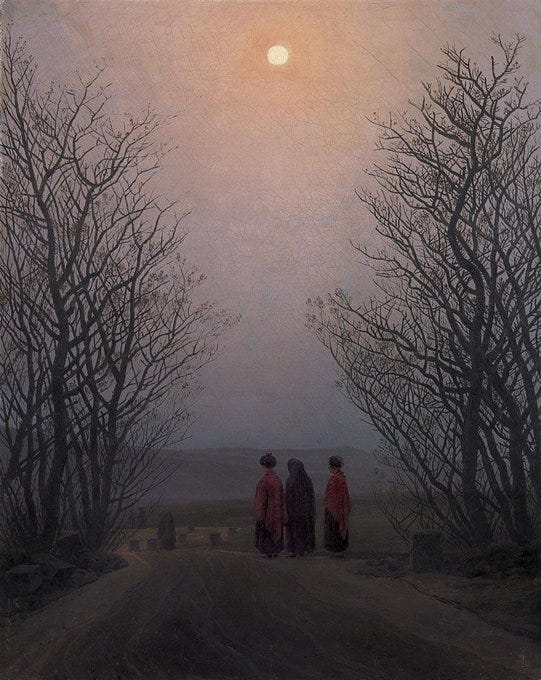Dear readers,
This blog is a labor of love. I do not charge for any of this sizzling hot content and I have decided I never will. Paywalls cannot and should not contain the Bacon; Bacon is for the people, by the people. But if you derive any enjoyment or value from what I post on here, I would ask two small favors: (1) share Secretorum with a friend, and (2) send me any articles/poems/quotes/art/music/whatever that you think I might enjoy and would want to feature on a future links post (and of course you will be credited along with any personal links to blogs/websites you would like to include). I will warn you though: the bar is high. As for what I’m looking for, anything that is truly strange, beautiful, grotesque, macabre, thought-provoking, humorous, or otherwise notable (you can reach me at rogersbacon17 at gmail.com).
THE STRANGE, THE BEAUTIFUL, THE GROTESQUE
1. Artist: Konstantin Korobov
2. Cormac McCarthy, The Road
Once there were brook trout in the streams in the mountains. You could see them standing in the amber current where the white edges of their fins wimpled softly in the flow. They smelled of moss in your hand. Polished and muscular and torsional. On their backs were vermiculate patterns that were maps of the world in its becoming. Maps and mazes. Of a thing which could not be put back. Not be made right again. In the deep glens where they lived all things were older than man and they hummed of mystery.
3. Photography by Angelica Ramirez
4. Your new favorite drug:
Jenkem is a inhalant and hallucinogen created from fermented human waste. In the mid-1990s, it was reported to be a popular street drug among Zambian youth.
In November 2007, there was a moral panic in the United States after widespread reports of jenkem becoming a popular recreational drug in middle and high schools across the country, though the true extent of the practice has since been called into question. Several sources reported that the increase in American media coverage was based on a hoax and on faulty Internet research.
The name derives from Genkem, a brand of glues which had “become the generic name for all the glues used by glue-sniffing children” in South Africa, where the drug originated and is most popular on the African continent today. In the book Children of AIDS: Africa's Orphan Crisis by Emma Guest, the making of jenkem is described: “fermented human sewage, scraped from pipes and stored in plastic bags for a week or so, until it gives off numbing, intoxicating fumes.” The process is similarly described in a 1995 IPS report: “Human excreta is scooped up from the edges of the sewer ponds in old cans and containers which are covered with a polyethylene bag and left to stew or ferment for a week.”
The effects of jenkem inhalation supposedly last for around an hour and consist of auditory and visual hallucinations for some users. A 1999 report interviewed a user, who said, “With glue, I just hear voices in my head. But with jenkem, I see visions. I see my mother who is dead and I forget about the problems in my life.”
5. From the Himalayan art exhibit at the Rubin Museum (NYC):
6. Herodotus (c. 484 – c. 425 BC):
“The storm lasted three days, after which the Magi brought it to an end by sacrificial offerings, and by putting spells on the wind, and by further offerings to Thetis and the sea-nymphs—or, of course, it may be that the wind just dropped naturally.”
THE SAD
7. Two words from the Dictionary of Obscure Sorrows:
Yù Yī (ancient Chinese): the longing to feel things intensely again.
This intensity of experience is abundant in our younger years—when we laughed hard, were filled with excitement, and felt completely carefree. And in the earliest stage of life, as infants, so much of our surroundings filled us with fascination. Intense feelings when we’re young make sense since this is when we’re exposed to so many new things. More routine and familiarity as we age might mean we don’t feel as intensely as often, but there will be instances when we are jolted awake from our routine and feel childhood sensations again.
Mono no aware (Japanese): The deep pathos inherent in all things because they are fleeting and ephemeral. A beautiful sadness in the passing of lives and objects. The bittersweet impermanence of autumn leaves, falling cherry blossoms, passing seasons, youth, romance, life.
8. Extinguished by Miles Johnston

THE READING, THE MATH, THE SCIENCE
9. “Cultivating a state of mind where new ideas are born”: enjoyed this a lot, many interesting reflections on the nature of creativity. The essay discusses the lives and creative processes of the Swedish film director Ingmar Bergman and the French mathematician Alexander Grothendieck. If you don’t know about Grothendieck (or even if you do know the broad strokes), I highly recommend this biographical essay—buckle up, it’s a wildddd ride.
Alexander Grothendieck started out as the greatest mathematician of the twentieth century, and ended up as a destitute hermit, lost in a labyrinth of ideas, dreams and maybe delusions that we still haven’t been able to decipher.
10. Surname Diversity, Social Ties and Innovation:
We study whether interactions between individuals with different skills, expertise and perspectives influenced innovation in U.S. counties from 1850 to 1940. We introduce and validate a new measure of social interactional diversity based on the distribution of surnames: lower surname diversity indicates more concentrated social interactions among like-minded people. Leveraging quasi-random variation in counties' surname compositions—stemming from the interplay between historical fluctuations in immigration and local factors that attract immigrants—we find that surname diversity increases both the quantity and quality of innovation. The results support the view that social interactions between diverse minds are key drivers of innovation.
11. This is the picture on the Wikipedia page for “Psychologist”; so many questions, so few answers…
12. “AI and the Doctor Dolittle challenge”:
Talking to animals is a fundamental human desire. The emergence of powerful AI algorithms, and specifically Large Language Models, has driven many to suggest that we are on the verge of fulfilling this wish. A few large scientific consortia have been formed around this topic and several commercial entities even offer such services. We frame the task of communicating with animals as ‘The Doctor Dolittle challenge’ and identify three main obstacles on the route to doing so. First, although generative AI models can create novel animal communication samples, it is very difficult to determine their context, and we will forever be biased by our human umwelt when doing so. Second, using AI to extract context in an unsupervised manner must be validated through controlled experiments aiming to measure the animals’ response. This is difficult, and moreover, AI algorithms tend to cling on to any available information and are thus prone to finding spurious correlations. And third, animal communication focuses on a restricted set of contexts, such as alarm and courtship, highly limiting our ability to communicate regarding other contexts. Nevertheless, using the tremendous power of novel AI methods to decipher and mimic animal communication is both fascinating and important. We thus define the criteria for passing the Doctor Dolittle challenge and call upon scientists to take on the mission.
I’m reminded of one of my favorite Ted Chiang short stories, “The Great Silence”
13. “To reverse engineer an entire nervous system” (aka The Worminator Project):
There are many theories of how behavior may be controlled by neurons. Testing and refining these theories would be greatly facilitated if we could correctly simulate an entire nervous system so we could replicate the brain dynamics in response to any stimuli or contexts. Besides, simulating a nervous system is in itself one of the big dreams in systems neuroscience. However, doing so requires us to identify how each neuron's output depends on its inputs, a process we call reverse engineering. Current efforts at this focus on the mammalian nervous system, but these brains are mind-bogglingly complex, allowing only recordings of tiny subsystems. Here we argue that the time is ripe for systems neuroscience to embark on a concerted effort to reverse engineer a smaller system and that Caenorhabditis elegans is the ideal candidate system as the established optophysiology techniques can capture and control each neuron’s activity and scale to hundreds of thousands of experiments. Data across populations and behaviors can be combined because across individuals the nervous system is largely conserved in form and function. Modern machine-learning based modeling should then enable a simulation of C. elegans’ impressive breadth of brain states and behaviors. The ability to reverse engineer an entire nervous system will benefit the design of artificial intelligence systems and all of systems neuroscience, enabling fundamental insights as well as new approaches for investigations of progressively larger nervous systems.
THE BORGES
14. Writing advice:
“A good sentence in English has a structure that begins with the second most important element, moves to the least important element, and ends with the strongest element. The pattern is 2-3-1.”
15. A (very) short story, “Ragnarök”:
In our dreams (writes Coleridge) images represent the sensations we think they cause; we do not feel horror because we are threatened by a sphinx ; we dream a sphinx in order to explain the horror we feel. If this is so, how could a mere chronicle of its forms transmit the stupor, the exaltation, the alarm, the menace and the jubilance which made up the fabric of that dream that night? I shall attempt such a chronicle, however; perhaps the fact that the dream was composed of one single scene may remove or mitigate this essential difficulty.
The place was the School of Philosophy and Letters; the time, toward sundown. Everything (as usually happens in dreams) was somehow different; a slight magnification altered things. We were electing officials: I was talking with Pedro Henríquez Ureña, who in the world of waking reality died many years ago. Suddenly we were stunned by the clamor of a demonstration or disturbance. Human and animal cries came from the Bajo. A voice shouted “Here they come!” and then “The Gods! The Gods!” Four or five individuals emerged from the mob and occupied the platform of the main lecture hall. We all applauded, tearfully; these were the Gods returning from a centuries-long exile. Made larger by the platform, their heads thrown back and their chests thrust forward, they arrogantly received our homage. One held a branch which no doubt conformed to the simple botany of dreams; another, in a broad gesture, extended his hand which was a claw; one of the faces of Janus looked with distrust at the curved beak of Thoth. Perhaps aroused by our applause, one of them — I know longer know which — erupted in a victorious clatter, unbelievably harsh, with something of a gargle and of a whistle. From that moment, things changed.
It all began with the suspicion (perhaps exaggerated) that the Gods did not know how to talk. Centuries of fell and fugitive life had atrophied the human element in them; the moon of Islam and the cross of Rome had been implacable with these outlaws. Very low foreheads, yellow teeth, stringy mulatto or Chinese mustaches and thick bestial lips showed the degeneracy of the Olympian lineage. Their clothing corresponded not to a decorous poverty but rather to the sinister luxury of the gambling houses and brothels of the Bajo. A carnation bled crimson on a lapel and the bulge of a knife was outlined beneath a close-fitting jacket. Suddenly we sensed that they were playing their last card, that they were cunning, ignorant and cruel like old beasts of prey and that, if we let ourselves be overcome by fear or pity, they would finally destroy us.
We took out our heavy revolvers (all of a sudden there were revolvers in the dream) and joyfully killed the Gods.
16. Artist: INFINITEYAY
THE MUSIC
17. Beats Antique - Three Sisters (feat. Tatyana Kalmykova)
18. Flying Lotus - Crust











